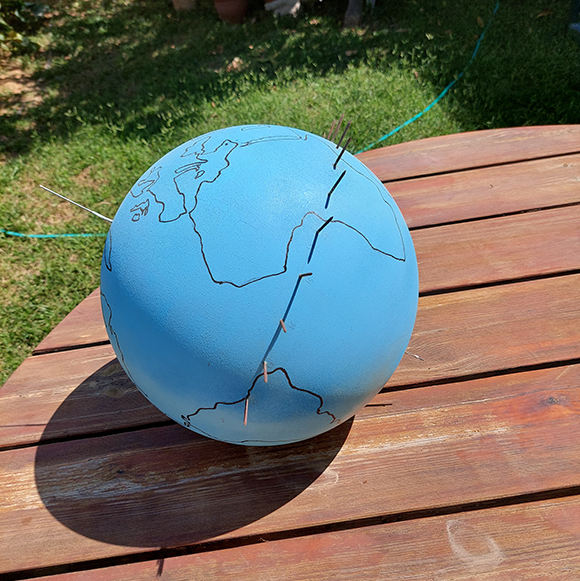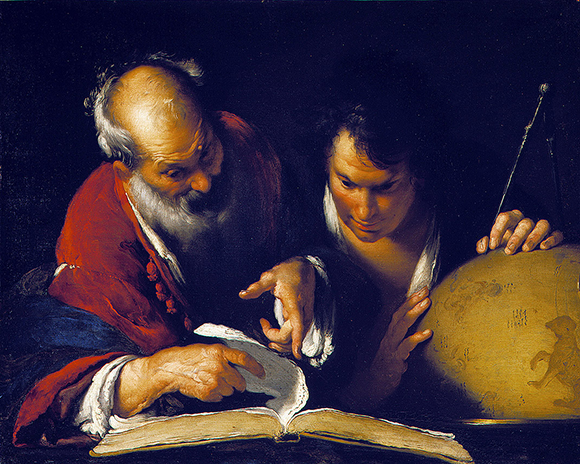Sometimes, a simple demonstration is all that's needed to convey complex and fascinating scientific ideas. In rarer cases, a single experimental setup can demonstrate several concepts simultaneously. The globe model displayed at the entrance hall of the Clore Garden of Science at the Weizmann Institute of Science is such an example. With the autumnal equinox approaching on September 22, it offers a wonderful opportunity to observe ancient astronomical concepts in action.
Equinox around the world
The astronomical calendar features four interesting days associated with the changing of the seasons, once considered the "Days of the Wrath of the Gods." These are the summer solstice - the longest day of the year in June in the Northern Hemisphere, the winter solstice - the shortest day of the year in December in the Northern Hemisphere, and the autumnal and vernal equinoxes in September and March, when day and night are of equal length.
These phenomena can be easily observed by positioning a globe model in the correct orientation in your backyard. To do this, align the globe’s axis parallel to the Earth’s axis using a compass and adjust the elevation angle of the model to match your latitude. This way, your location will appear at the topmost part of the globe, parallel to the ground (see pictures below). Half of the globe will be illuminated, and the other half will be in shadow. As shown, during the autumnal or vernal equinox, the sunset line, separating light from shadow, will be perpendicular to the equator, remaining this way throughout the day.
4 View gallery


Equinoxes and solstices on the Rishpon Globe. From left to right: summer solstice, vernal and autumnal equinoxes, winter solstice
(Photo: Dr. Moshe Rishpon)
This model was the first of its kind in the world, mounted by Dr. Moshe Rishpon, founder of the Clore Garden of Science and the Youth Activities Unit at the Weizmann Institute of Science in Rehovot, Israel, from which the Davidson Institute for Science Education emerged and developed. Dr. Rishpon, who resides at the Weizmann Institute, recently celebrated his 90th birthday. His passion and enthusiasm for science and the wonders of nature continues to amaze and inspire his colleagues, many of whom are a generation or two younger (including the author of this article). The globe model he devised has been referred to in literature as "Rishpon’s Globe.”
The original idea for the model came to Dr. Rishpon during the Yom Kippur War, which broke out fifty-one years ago. During night watches, while conversing with his comrades, he realized how few people truly understood the reasons behind the changing seasons. This sparked his determination to find ways to change that by simplifying and effectively demonstrating these concepts.
Any hour is a good hour
In one of its versions, the globe features a row of 24 small posts positioned at fixed 15-degree intervals along the equator, functioning as a spherical sundial. By observing the direction of the shadows cast by the posts, one can instantly determine the time at that longitude. The post casting the shortest shadow marks noon, with each adjacent post corresponding to a one-hour difference. On “regular” days, the shadows tilt either north or south of the equator. However, at noon on the autumnal equinox, one of the posts casts no shadow at all, while all other shadows align perfectly with the equator.
4 View gallery


Spherical sundial. The Rishpon globe with the posts along the equator, as photographed in Dr. Moshe Rishpon’s yard on September 19, 2023
(Photo: Dr. Moshe Rishpon)
A circumferential experiment
Eratosthenes, a Greek mathematician and astronomer, moved to Egypt to work as a librarian at the Great Library of Alexandria. Over two thousand years ago, he - like Aristotle before him - recognized that the Earth was a sphere. This was a radical concept for his time and wouldn't gain widespread acceptance until the days of Galileo, Copernicus, and Kepler. Yet, Eratosthenes reasoned that if the Earth was a sphere, it must have a measurable circumference - so why not measure it?
He knew that at noon on the longest day of the year, the sun was directly overhead for an observer in the city of Syene (known as Swenet in ancient Egyptian and modern-day Aswan) in Egypt. There was a well in the city, and at that specific day and time, the sun shone directly above it, illuminating its bottom, showing that the sun was perfectly vertical.
In contrast, in the city of Alexandria, north of Syene, there was a column that cast a shadow. Eratosthenes measured the shadow at noon on the longest day of the year and, using simple geometry, calculated that the apex angle of the triangle formed by the column and its shadow was 7.2 degrees.
4 View gallery


Moved to Egypt to work at the Great Library of Alexandria. Eratosthenes teaching in Alexandria | Bernardo Strozzi, 1635
(Photo: Wikipedia)
This same angle defines the corresponding sector of the Earth's circumference, stretching from Alexandria to Syene (see illustration). Thus, the ratio of 7.2 degrees to the full 360 degrees of a circle is equivalent to the ratio between the distance from Alexandria to Syene and the Earth's circumference. Eratosthenes knew that a camel caravan took roughly 50 days to travel the distance between these points, and by measuring its average speed, he estimated the distance to be around 5,000 stadia – about 833 kilometers in modern terms.
From this, he calculated the Earth's circumference to be approximately 41,700 kilometers. The actual circumference of the Earth, as we know today, is about 40,100 kilometers, making Eratosthenes' calculation astonishingly accurate. However, his extraordinary achievement remained largely unknown for many centuries, until it was rediscovered during the Middle Ages.
4 View gallery


Calculated the Earth's circumference using a column and geometry. Illustration of Eratosthenes' calculation
(Photo: Wikipedia, David Monniaux)
It’s no surprise that the Rishpon globe allows for replicating this experiment. At noon on the summer solstice, simply place a small vertical column at the location of Alexandria on the globe and measure its shadow length. It's a fantastic educational experience to try at school or in the backyard – bringing this ancient experiment to life and literally placing you 'on the globe.
Special thanks to my friend Dr. Moshe Rishpon for the idea and insights for this article.
Get the Ynetnews app on your smartphone:

